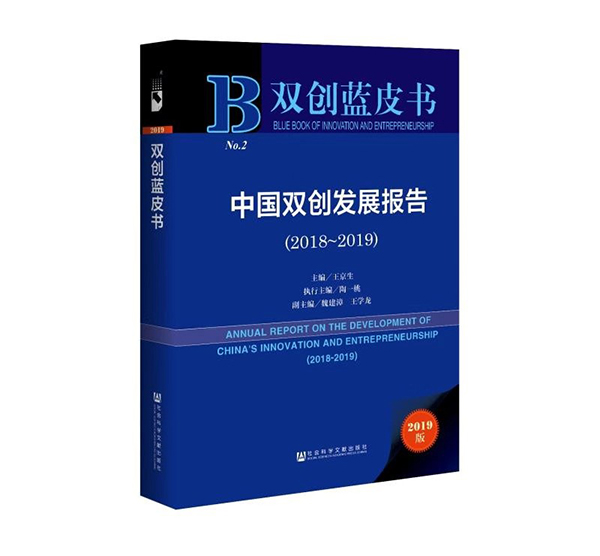The Blue Book of Innovation and Entrepreneurship: Annual Report on the Development of China’s Innovation and Entrepreneurship (2018-2019) (the “Blue Book”) made its debut in Shenzhen on December 13. The chief editor of the Blue Book is Wang Jingsheng, State Council Counselor, and the executive chief editor is Prof. Tao Yitao, Director of China Center for Special Economic Zone Research (CCSEZR) of SZU and President of the Belt and Road Research Institute (Shenzhen) for International Cooperation and Development (BRRI). Its press conference was co-staged by the China Center for Special Economic Zone Research (CCSEZR) of Shenzhen University (SZU) and the Social Sciences Academic Press (SSAP). Among the attendees were Li Youwei, Former Secretary of the CPC Shenzhen Municipal Committee, Xie Shouguang, President of the SSAP, and members of the research group.

Li Youwei (second from left), Wang Jingsheng (second from right), Tao Yitao (first from right), and Xie Shouguang (first from left)
In 2018, the Chinese State Council released a plan on promoting high-quality and upgraded mass entrepreneurship and innovation. In this plan, entrepreneurship and innovation was raised to a national strategic level and taken to the next stage with government supports giving momentum to it for further progress, yet urban development remained the main theme and carrier of the “entrepreneurship and innovation” strategy. Based on the entrepreneurship and innovation research in China and abroad, the Annual Report on the Development of China’s Innovation and Entrepreneurship (2018-2019) develops a comprehensive and quantitative framework to holistically assess the innovation environment and capabilities of major cities in China, with an aim to provide practical reference for policymakers.

Annual Report on the Development of China’s Innovation and Entrepreneurship (2018-2019)
By comparing the theories and approaches to entrepreneurship and innovation indexes in China and abroad, the Blue Book develops an entrepreneurship and innovation index evaluation model that fits in China’s actual national conditions from three pillars: Environmental Support, Resources & Capabilities, and Performance & Value. Through the collection, processing and computing analysis of relevant data from 100 cities across China (4 centrally-administered municipalities and 96 prefecture-level administrative regions), the model was exploited to carry out comprehensive and multiple-dimensional evaluation of the cities’ entrepreneurship and innovation development. According to the comprehensive evaluation result, Shenzhen tops the list of entrepreneurship and innovation cities, while Beijing and Shanghai took the second and third place respectively. The Blue Book also points out that the overall development of entrepreneurship and innovation in the economically developed eastern regions is generally better than that in the central and western regions, and the cities with extensive growth model get lower scores in term of the Performance & Value pillar. Overall, 38 of the top 50 cities in terms of Overall Entrepreneurship and innovation Index are eastern cities, and almost all of the Bottom 50 are mid-west cities.
The environment, resources and performance of entrepreneurship and innovation are all affected by different metrics and factors, among which the regional factors are the most significant ones. Compared with cities in the northeast and west, first-tier and regional hub cities, which have abundant high-quality human resources and knowledge-intensive companies, show great superiority in entrepreneurship and innovation resources; the Yangtze and Pearl River Delta regions, which are characterized by typical labor-intensive industries and are main clusters of manufacturing and innovative industries, have a relatively remarkable dominance in environment and performance of entrepreneurship and innovation. To redress this regional imbalance, it is imperative to value the coupling between regional factors and regional competitive industries while accelerating the development of maker platforms in various market segments, all in pursuit of improved entrepreneurship and innovation efficiency with diversified models.
The Blue Book consists of four parts: General Report, Entrepreneurship and Innovation Indexes, Industries, and International Findings.
In the Industries, the Blue Book delves into the influence patterns and paths of the following elements and conditions on entrepreneurship and innovation: transportation, financial, institutional and legal environment. In respect of transportation, the construction of the high-speed rail has expedited the collaborative development of regional innovation and entrepreneurship, and motivated the aggregation of manufacturing headquarters in developed cities and the spillover of innovation in core cities. With regard to financial conditions, the Blue Book takes the building of a data-driven hierarchical service system in Nanshan District as a subject, where the precise and efficient interaction between government, financial institutions and enterprises creatively addresses the problem of low availability and high cost of financing during the course of entrepreneurship and innovation for small- and medium-sized enterprises. For institutional conditions, the Blue Book takes the life science industry as an example and points out that we should expedite the transition in innovation from the Generalized System of Preferences (GSP) to the targeted system of preferences, and hasten the removal of institutional barriers to the development of specific sectors. In terms of the rule of law, the Blue Book highlights that the administrative and judicial protection systems should be in place in synergy with intellectual property protection, and the theoretical research on intellectual property in civil law regime should be reinforced. These studies provide method and path references for nationwide entrepreneurship and innovation.
In International Findings, the Blue Book presents the latest news of the global innovation organizations and innovative cities from three dimensions: enterprises, industries and cities. On the enterprises front, the Blue Book looks into the innovation and entrepreneurship developments of foreign-funded enterprises in Shenzhen, and finds out that they has continuously ramp up their R&D efforts since 2014. From the industries pillar, the Blue Book delves into the development of hydrogen fuel cell vehicles in Japan, which presents another useful development path and pattern of the electric vehicles powered by the new energy. For the construction of innovation hub cities, the studies show that the internationalization is the only route, the regional integration is an inherent requirement, the rule of law-based system is the basic guarantee, and the institutional innovation is the fundamental path. The Blue Book, presenting a profound analysis from both detail-oriented and big-picture perspective, provides a valuable reference for scholars and policymakers.
Related Reports
http://world.people.com.cn/n1/2019/1213/c1002-31505047.html?from=singlemessage&isappinstalled=0
- Shenzhen Special Zone Daily:
http://sztqb.sznews.com/MB/content/201912/14/content_789230.html?from=groupmessage&isappinstalled=0
https://m.thepaper.cn/newsDetail_forward_5229145?from=singlemessage&isappinstalled=0
- 21st Century Business Herald:
https://m.21jingji.com/article/20191213/herald/fc6b4ad41a57f275c050886fdaba1b60.html
- SZTV News of Shenzhen TV:
http://static.scms.sztv.com.cn/ysz/zx/zw/28383834.shtml

